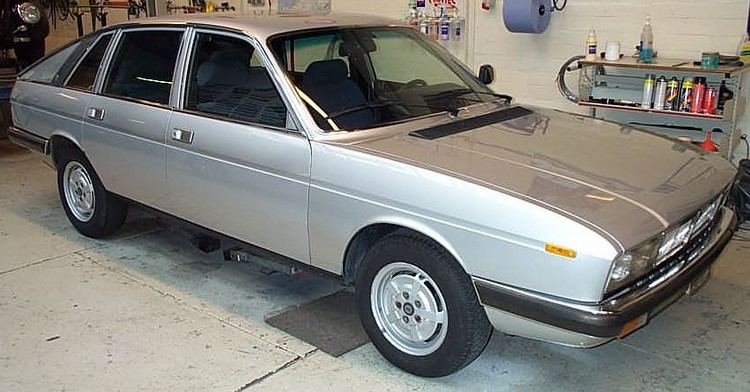Production 1976-1984 Layout FF layout | ||
 | ||
Body style 4-door fastback saloon (berlina)2-door coupé | ||
The Lancia Gamma (Tipo 830) was an executive car (E-segment in Europe) from Italian Fiat Auto's up-scale Lancia marque. Presented in 1976 at the Geneva Motor Show as Lancia's new flagship, it filled the void in Lancia's lineup left by the demise of the Flavia. The Gamma was made until 1984 as a 4-door fastback saloon (called Berlina) and 2-door coupé (presented in 1977), both designed by Pininfarina.
Contents
There were 15,272 berlinas and 6,790 coupés built. As with several other cars of the period, the fastback style of the berlina featured a conventional boot at the rear, and was not a hatchback, despite its appearance. At the car's press launch Pininfarina explained that a hatchback was avoided to save the inconvenience to back seat passengers when luggage is being loaded: "inconvenience" was thought to be a reference to possible draughts.
The name
Gamma is the third letter of the Greek alphabet. Greek letters had been used to denote Lancia models before 1945, and this tradition was revived with the presentation of the front-wheel drive Lancia Beta in 1971, the first Lancia to be developed under Fiat supervision. The Gamma can be seen as a continuation, also being FWD and utilizing some suspension elements from the Beta, so the choice of the following Greek character (Beta is second) appears as logical. The Gamma sports the γ (lower case gamma) sign on several badges both inside and outside.
Engines
The Lancia Gamma was a front-wheel drive car with longitudinally-mounted boxer engines. It was available with either a 5-speed manual transmission or later a 4-speed automatic transmission. There were effectively two series of the Gamma, though Lancia referred to the change merely as a "face-lift". The main change was that the engines went from carburettors to Bosch L-Jetronic fuel injection. At the same time a lot of cosmetic work was done; the cars got a new corporate grille, 15-inch "sunburst" alloy wheels, and a slightly upgraded interior, with new instrumentation and interior lighting, new badging, a new style handbrake and gear lever gaitor.
Lancia developed unique flat-4 engines for the Gamma (an idea initially was to use a Fiat V6). Engine designer De Virgilio also drew up an engine for the Gamma which was a V6 4-cam with either 3- or 4-litre displacement, but this never came to fruition. The Flat four engine finally chosen for the Gamma lacked the cachet afforded to luxury cars in this sector, which generally came with 6 or 8 cylinders. The 4-cylinder engine was unusually large for a modern 4-cylinder petrol engine, though Subaru EJ flat-4 engines matched it in volume and the Porsche 944 and 968 had 3L straight-4 engines. The "4" had certain engineering advantages, but more than anything it allowed Aldo Brovarone (Pininfarina chief stylist) to design a rakish looking coupé with a low bonnet line and a steeply raked windscreen. When launched at the Geneva show in 1979 there were crowds around the Lancia stand. Pressure cast in alloy with wet cylinder liners, the engine was also extremely light and though it only produced 140 bhp (104 kW), (120 bhp (89 kW) in 2.0-litre form) in line with traditional Lancia thinking it generated a huge amount of torque, most of which was available at just 2000 rpm.
Initially available with a displacement of 2.5 L (Gamma 2500), it was later joined by a 2.0 L version (Gamma 2000), which resulted from the Italian tax system (cars with engines larger than 2.0 L are subject to heavier tax burden). The displacement was lowered by decreasing the bore rather than the stroke of the engine. Both displacements were using Weber carburetors, and the 2.5 L also came in a version fitted with fuel injection (Gamma 2500 I.E.)
Ironically, it was the engines that caused the Gamma to have a poor name. They overheated far too easily, wore its cams, and leaked oil. The wishbone bushes wore out early, and, because the power steering was driven from the left cam-belt, the car was prone to snapping that belt when steering was on full lock — with disastrous results. By the time the FL1 was launched most of these problems had been addressed, but the damage was done, and the car's poor reputation cemented. The whole marque suffered from similar reputation problems; compare with the Lancia Beta.
*stated by Pininfarina production records
Concepts
Several concepts were developed from the Gamma Platform over the years:
